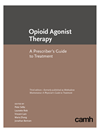Text adapted in 2023 from "Opioid Use and Opioid Use Disorders" in The Primary Care Addiction Toolkit. Revised version available online only.
Titration of opioids
Careful titration is important with patients at high risk of addiction because the euphoric effects of opioids and the risk of overdose are dose-related.
Specific titration protocols are outlined in Management of Chronic Non-cancer Pain (Centre for Effective Practice, 2018a). With each dose increase, the patient should report a graded analgesic response (e.g., pain rating will drop from 8 out of 10 to 7).
Titrate the opioid until an effective dose is reached or until further increases are not tolerated. The goal is to use the lowest effective dose to manage pain. The Canadian Guideline for Opioids for Chronic Non-cancer Pain (Busse et al., 2017) recommends restricting the prescribed dose to less than 90 mg morphine equivalents daily (MED) for patients who are beginning opioid therapy. Most patients respond to doses in the range of 050 mg MED, and clinicians should reassess the benefits and risks before increasing doses above 50 mg MED.
For some patients, doses of more than 90 mg MED may be beneficial; however, guidelines recommend getting a second opinion from a colleague or a pain specialist (Busse et al., 2017).
Optimal opioid dose
An optimal opioid dose is one that produces an important difference in pain (30 per cent pain reduction or 2 points on an 11-point scale) or an improvement in functioning, and where further dose increases provide no additional pain relief. The optimal dose also has minimal side effects and no serious complications.


